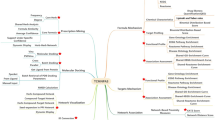Abstract
Data mining is a hotspot in the traditional Chinese medical (TCM) field now. Because it glosses over the relation between herbals, the traditional Chinese medical formula (CMF) data organization method, in which different records are concerned different CMFs, cannot meet the need for deep data analysis. This paper proposes an effective approach for CMF networking according to the Jaccard similarity coefficient; then we carried out an analysis of the CMF network features which shows the CMF network has properties of complex network. Meanwhile, an algorithm for core herbal discovery is presented basing on key nodes discovery method and the MapReduce [1] parallel programming framework. The result indicates the feasibility of our ideas and the validity of the algorithm.
Access this chapter
Tax calculation will be finalised at checkout
Purchases are for personal use only
Preview
Unable to display preview. Download preview PDF.
Similar content being viewed by others
References
Dean, J., Ghemawat, S.: MapReduce: Simplified Data Processing on Large Clusters. Google, Inc. (2004)
He, Y., Zhang, P.P., Tang, J.-Y.: A Collaboration Network Description on Tradition-al Chinese Medical Prescription Formulation System. Science & Technology Review 23(11), 36–39 (2005)
Zhou, X., Liu, B.: Network Analysis System for Traditional Chinese Medicine Clinical Data. Biomedical Engineering and Informatics (2009)
Lam, C.: Hadoop in Action, pp. 4–9. Manning Publications (2010)
Zipf, G.K.: Human behavior and the principle of least effort. Addison-Wesley Press, Oxford (1949)
Ferrer, R., Sole, R.V.: Least effort and the origins of scaling in human language. PNAS 100, 788–791 (2003)
Albert, R., Barabasi, A.-L.: Statistical mechanics of complex networks. University of Notre Dame, pp. 71–75 (2002)
Page, L.: The Page-Rank citation ranking: Bringing order to the Web. Stanford Digital Library Project (1998)
DeWitt, D.J., Gray, J.: Parallel database systems: The future of high performance database systems. Communications of the ACM 35(6), 85–98 (1992)
Author information
Authors and Affiliations
Editor information
Editors and Affiliations
Rights and permissions
Copyright information
© 2012 Springer-Verlag Berlin Heidelberg
About this paper
Cite this paper
Yuan, G., Zheng, L., Chong-Jun, W., Xin-Sheng, F., Jun-Yuan, X. (2012). Chinese Medicine Formula Network Analysis for Core Herbal Discovery. In: Zanzotto, F.M., Tsumoto, S., Taatgen, N., Yao, Y. (eds) Brain Informatics. BI 2012. Lecture Notes in Computer Science(), vol 7670. Springer, Berlin, Heidelberg. https://doi.org/10.1007/978-3-642-35139-6_24
Download citation
DOI: https://doi.org/10.1007/978-3-642-35139-6_24
Publisher Name: Springer, Berlin, Heidelberg
Print ISBN: 978-3-642-35138-9
Online ISBN: 978-3-642-35139-6
eBook Packages: Computer ScienceComputer Science (R0)




